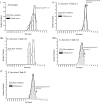2CS-CHXT Operon Signature of Chlorhexidine Tolerance among Enterococcus faecium Isolates
- PMID: 31562170
- PMCID: PMC6856339
- DOI: 10.1128/AEM.01589-19
2CS-CHXT Operon Signature of Chlorhexidine Tolerance among Enterococcus faecium Isolates
Abstract
Chlorhexidine (CHX) is a broad-spectrum antiseptic widely used in community and clinical contexts for many years that has recently acquired higher relevance in nosocomial infection control worldwide. Despite this, CHX tolerance among Enterococcus faecium bacteria, representing one of the leading agents causing nosocomial infections, has been poorly understood. This study provides new phenotypic and molecular data for better identification of CHX-tolerant E. faecium subpopulations in community and clinical contexts. The chlorhexidine MIC (MICCHX) distribution of 106 E. faecium isolates suggested the occurrence of tolerant subpopulations in diverse sources (human, animal, food, environment) and phylogenomic backgrounds (clades A1/A2/B), with predominance in clade A1. They carried a specific variant of the 2CS-CHXT operon, identified here. It encodes glucose and amino acid-polyamine-organocation family transporters, besides the DNA-binding response regulator ChtR, with a P102H mutation previously described only in CHX-tolerant clade A1 E. faecium, and the ChtS sensor. 2CS-CHXT seems to be associated with three regulons modulating diverse bacterial biological functions. Combined data from normal MIC distribution and 2CS-CHXT operon characterization support a tentative epidemiological cutoff (ECOFF) of 8 mg/liter to CHX, which is useful to detect tolerant E. faecium populations in future surveillance studies. The spread of tolerant E. faecium in diverse epidemiological backgrounds calls for the prudent use of CHX in multiple contexts.IMPORTANCE Chlorhexidine is one of the substances included in the World Health Organization's list of essential medicines, which comprises the safest and most effective medicines needed in global health systems. Although it has been widely applied as a disinfectant and antiseptic in health care (skin, hands, mouthwashes, eye drops) since the 1950s, its use in hospitals to prevent nosocomial infections has increased worldwide in recent years. Here, we provide a comprehensive study on chlorhexidine tolerance among strains of Enterococcus faecium, one of the leading nosocomial agents worldwide, and identify a novel 2CS-CHXT operon as a signature of tolerant strains occurring in diverse phylogenomic groups. Our data allowed for the proposal of a tentative epidemiological cutoff of 8 mg/liter, which is useful to detect tolerant E. faecium populations in surveillance studies in community and clinical contexts. The prediction of 2CS-CHXT regulons will also facilitate the design of future experimental studies to better uncover chlorhexidine tolerance among E. faecium bacteria.
Keywords: 2CS-CHXT operon; Enterococcus faecium; chlorhexidine tolerance; epidemiological cutoff.
Copyright © 2019 American Society for Microbiology.
Figures

Similar articles
-
Evolution of Chlorhexidine Susceptibility and of the EfrEF Operon among Enterococcus faecalis from Diverse Environments, Clones, and Time Spans.Microbiol Spectr. 2022 Aug 31;10(4):e0117622. doi: 10.1128/spectrum.01176-22. Epub 2022 Jul 7. Microbiol Spectr. 2022. PMID: 35862993 Free PMC article.
-
The Two-Component System ChtRS Contributes to Chlorhexidine Tolerance in Enterococcus faecium.Antimicrob Agents Chemother. 2017 Apr 24;61(5):e02122-16. doi: 10.1128/AAC.02122-16. Print 2017 May. Antimicrob Agents Chemother. 2017. PMID: 28242664 Free PMC article.
-
Insights towards the impact of subinhibitory chlorhexidine on antimicrobial susceptibility and horizontal gene transfer in Enterococcus faecium.Sci Total Environ. 2025 Apr 1;972:179064. doi: 10.1016/j.scitotenv.2025.179064. Epub 2025 Mar 13. Sci Total Environ. 2025. PMID: 40086311
-
Occurrence and spread of antibiotic resistances in Enterococcus faecium.Int J Food Microbiol. 2003 Dec 1;88(2-3):269-90. doi: 10.1016/s0168-1605(03)00190-9. Int J Food Microbiol. 2003. PMID: 14597000 Review.
-
Evolution of virulence in Enterococcus faecium, a hospital-adapted opportunistic pathogen.Curr Opin Microbiol. 2018 Feb;41:76-82. doi: 10.1016/j.mib.2017.11.030. Epub 2017 Dec 9. Curr Opin Microbiol. 2018. PMID: 29227922 Review.
Cited by
-
The mobilome landscape of biocide-resistance in Brazilian ESKAPE isolates.Braz J Microbiol. 2024 Dec;55(4):3603-3616. doi: 10.1007/s42770-024-01450-7. Epub 2024 Jul 19. Braz J Microbiol. 2024. PMID: 39028534 Free PMC article.
-
Current insights into the effects of cationic biocides exposure on Enterococcus spp.Front Microbiol. 2024 Jun 25;15:1392018. doi: 10.3389/fmicb.2024.1392018. eCollection 2024. Front Microbiol. 2024. PMID: 39006755 Free PMC article. Review.
-
Unraveling Enterococcus susceptibility to quaternary ammonium compounds: genes, phenotypes, and the impact of environmental conditions.Microbiol Spectr. 2023 Sep 22;11(5):e0232423. doi: 10.1128/spectrum.02324-23. Online ahead of print. Microbiol Spectr. 2023. PMID: 37737589 Free PMC article.
-
Optimal effective concentration combinations (OPECCs) for binary application of membrane-targeting antiseptics and TMPyP-mediated antimicrobial photodynamic therapy.Photochem Photobiol Sci. 2024 Jan;23(1):189-196. doi: 10.1007/s43630-023-00512-3. Epub 2023 Dec 19. Photochem Photobiol Sci. 2024. PMID: 38113026
-
Evolution of Chlorhexidine Susceptibility and of the EfrEF Operon among Enterococcus faecalis from Diverse Environments, Clones, and Time Spans.Microbiol Spectr. 2022 Aug 31;10(4):e0117622. doi: 10.1128/spectrum.01176-22. Epub 2022 Jul 7. Microbiol Spectr. 2022. PMID: 35862993 Free PMC article.
References
-
- World Health Organization. 2017. The selection and use of essential medicines: report of the WHO expert committee, 2017 (including the 20th WHO model list of essential medicines and the 6th WHO model list of essential medicines for children). World Health Organization, Geneva, Switzerland.
Publication types
MeSH terms
Substances
LinkOut - more resources
Full Text Sources
Medical

